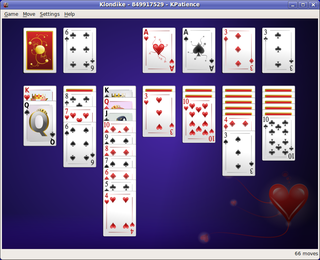Related Research Articles

Calculation is a solitaire card game played with a standard pack of 52 cards. It is part of the Sir Tommy family of patience games. It has its origin in France, where it is known as La Plus Belle.
Eight Off is a patience or solitaire card game, named after its employment of eight cells, played with one deck of playing cards. The object of the game is to move all the cards into the foundations. It served as a partial inspiration for and is very similar to the popular solitaire game FreeCell.

Napoleon at St Helena is a patience or solitaire card game. It is quite difficult to win, and luck-of-the-draw is a significant factor. It is also popularly known as Forty Thieves.

Baker's Dozen is a solitaire card game using a deck of fifty-two playing cards. The game is so called because of the 13 columns in the game, the number in a baker's dozen.
Beleaguered Castle is a patience or solitaire card game played with a deck of 52 playing cards. It is sometimes described as "Freecell without cells" because its game play is somewhat akin to the popular solitaire computer game of that name but without extra empty spaces to maneuver. Beleaguered Castle is also called Laying Siege and Sham Battle.
British Square is a solitaire card game which uses two decks of 52 playing cards each. It is a fan-type game in the style of La Belle Lucie. It has an unusual feature of switchback building whereby each foundation is first built up and then built down.
Crescent is a solitaire card game played with two decks of playing cards mixed together. The game is so called because when the cards are dealt properly, the resulting piles should form a large arc or a crescent. An alternative and less common name for the game is La Demi-Lune.

Diplomat is a patience or solitaire card game which is played using two decks of playing cards shuffled together. Its layout is similar to that of Beleaguered Castle, and the game-play is similar to Forty Thieves. It can be completed successfully more often than not.
Duchess is a patience or solitaire card game which uses a deck of 52 playing cards. It has all four typical features of a traditional solitaire game: a tableau, a reserve, a stock and a waste pile, and is quite easy to win. It is closely related to Canfield.

Miss Milligan is a patience game which is played using two decks of playing cards. According to Peter Arnold, author of Card Games for One, this classic game's enduring popularity is in part due to its amazing tendency to enable complete recovery from seemingly hopeless positions. Winning chances with good play are about 1 in 20 games.
Napoleon's Square is a patience or solitaire card game which uses two decks of playing cards. First described in a revised edition of Lady Cadogan's Illustrated Games of Patience or Solitaire in the early 1900s, it is an easy variation of Forty Thieves. It is not determined if Napoleon actually played this game, or any solitaire game named after him.
Deuces is a solitaire card game which is played with two decks of playing cards. It is so called because each foundation starts with a "deuce", or two card. It also belongs to a family of card games which includes Busy Aces, which is derived from Forty Thieves.
British Constitution is a solitaire card game played with two decks of playing cards. It is a card game with a high chance in winning.
Zodiac is a solitaire card game which is played with two decks of playing cards shuffled together. An old game, it first appeared in Lady Adelaide Cadogan's book Illustrated Games of Patience. It is so-named probably because of its "globe"-shaped layout. It had many variations until its rules were standardized in 1914.
Jubilee is the name given to two solitaire card games, both played with two decks of playing cards. Both games are so-called because they were created during the time of the Golden Jubilee of Queen Victoria in 1887. One of the games has an ornate layout, while the other is simpler and it belongs to the family of games which include Sir Tommy, Strategy, and Calculation.

Patience (Europe), card solitaire or just solitaire (US/Canada), is a genre of card games that can be played by a single player. Patience games can also be played in a head-to-head fashion with the winner selected by a scoring scheme.
Following is a solitaire card game which uses a deck of playing cards. It is so called because a player has to follow a rotation of suits. It was first described in the book Games of Patience and has since seen appeared in other books and solitaire software.
Tableau a solitaire card game played with two decks of playing cards.

La Belle Lucie is a solitaire card game where the object is to build the cards into the foundations. It is considered to be representative of the "fan" family of solitaire card games, and has a pleasing layout.
Well is a solitaire card game played with a deck of 52 playing cards. Its layout and rules are similar to Beleaguered Castle. This game is nearly always solvable, but many deals prove very difficult to win.
References
- ↑ "Fortress" (p.31) in The Little Book of Solitaire, Running Press, 2002. ISBN 0-7624-1381-6
- ↑ "Fortress" (p.199) in Hoyle's Rules of Games (3rd edition) by Philip D. Morehead (ed.), 2001. ISBN 0-451-20484-0
- ↑ Cadogan, Adelaide, 1914. Lady Cadogan's Illustrated Games of Solitaire or Patience (New Revised Edition, including American Games). David McKay Company, Philadelphia
- ↑ "Chessboard" (p.200) in Hoyle's Rules of Games (3rd edition) by Philip D. Morehead (ed.), 2001. ISBN 0-451-20484-0
